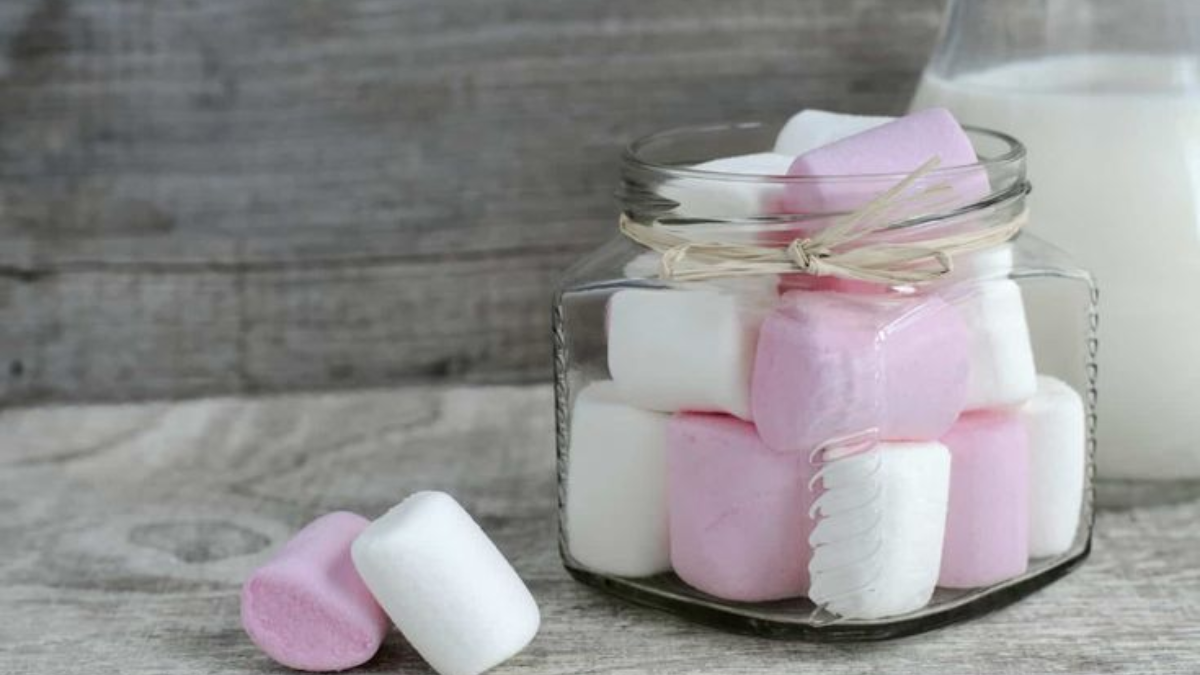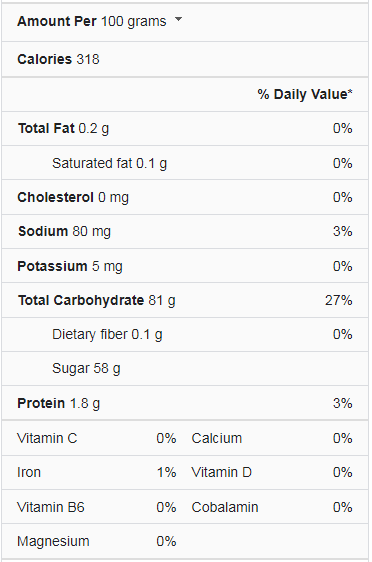Many of us like to consume marshmallows as a delicious treat with hot chocolate, on top of sweet potatoes, or even molded into Peeps for Easter. However, these light white puffs aren’t very nourishing. Typically, gelatin, corn syrup, and sugar make up marshmallow ingredients. However, if you consume more than one serving, the calories in marshmallows can mount up rapidly. No other confection has a texture like a marshmallow. They are soft, fluffy, and chewy and would happily float on top of a cup of cocoa, but when cooked or toasted over a campfire, they will melt and become gooey and crispy.
In addition to being delicious, marshmallows are quite cool since they can be lit to provide a wonderful light source in pitch-black camping. In a strict sense, marshmallows are a confection, a sweet. Since the mid-1800s, they have existed in our familiar form. Marshmallows got their name because an early recipe called for the sap from the marshmallow plant’s roots.
Marshmallow Nutrition Facts
What is Marshmallow?
Whether you create marshmallows at home or in a candy factory, they are made using sugar, corn syrup, and gelatin. Whipped air, however, is the main component. Although air isn’t usually considered an ingredient, it gives marshmallows their distinctive texture, along with other foods like whipped cream, meringue, angel food cake, and even scrambled eggs.
In hot cocoa, hot chocolate, s’mores, tea cakes, Easter sweets, marshmallows and chocolate are a traditional pairing. Baked sweet potatoes with marshmallows on top are a classic Thanksgiving side dish. Inventive additives like peppermint, roasted coconut, almonds, and sprinkles are frequently used to make hand-crafted artisanal marshmallows.
The ingredients for manufacturing marshmallows are sugar, corn syrup, and water, which are then combined and brought to a boil. The marshmallows are sweetened with sugar syrup, which also contributes to the texture of the marshmallows when heated to a particular temperature.
The mixture is whisked to incorporate air once the gelatin has been added. The marshmallows’ chewy form is maintained by gelatin, which helps them set up. At this point, if any additional flavorings or colors need to be added, like with Marshmallow Peeps, they are.
Extruding machines are used by candy manufacturers to apply intense pressure through long tubes and push the whipped marshmallow mixture. This technique extracts thick marshmallows ropes, which are cut into soft, cylindrical pieces. After being dusted with cornstarch to prevent sticking together, the individual marshmallows are placed into bags and sent to retailers.
Marshmallow-Making History
It should be noted that this method differs greatly from how marshmallows were created before the invention of extruding machines in the 1950s. Before that, marshmallows had to be manufactured by hand, which was time-consuming and required the individual marshmallows to “sweat” for several hours to form their outer skin.
Additionally, marshmallows could not have been pushed with as much air before the invention of extruding machines, which work under high pressure. They were noticeably less fluffy before that. And in contrast to today, egg whites were used in their preparation back then to maintain their shape better.
How to Make your Marshmallows?
Making your marshmallows is simple in contrast. Gelatin is added to a mixture of sugar, salt, water, and corn syrup after it has been cooked, and then the mixture is whipped in a stand mixer until it is frothy and light. Pour the mixture onto the baking dish that has been previously dusted with powdered sugar, and then sprinkle sugar on top of the marshmallow.
Flip the slab onto a cutting board once it has dried, then cut it into squares. Be aware that the sliced sides remain sticky after cutting. Sprinkles, melting chocolate, or simply eating them plain are all acceptable ways to customize them.
How Healthy are Marshmallows?
Only a small number of poor-quality clinical research provide evidence for the following claimed marshmallow advantages. Any of the uses for marshmallows stated below cannot be backed up by enough evidence. Before eating marshmallows, don’t forget to see a physician; it must never be used in place of recognized medical treatments.
Cough
Clinical studies indicate that extracts from the marshmallow plant may lessen the intensity and length of coughing. For instance, marshmallow lozenges and syrup were proven to relieve cough symptoms within 10 minutes in a study of 822 patients with dry cough brought on by throat irritation.
A marshmallow extract syrup lessened the frequency and intensity of dry coughing linked to throat discomfort in additional research, including 313 kids. In a different clinical trial, marshmallow extract was used to treat the dry cough that can occur as a side effect of the blood pressure medicine ACE inhibitors. Researchers studied 60 patients with ACEI-related cough and discovered that those who took marshmallows had less acute coughing than those who received a placebo.
Skin Health
A topical paste with marshmallow extract may speed up recovery in people with cutaneous leishmaniasis, a parasitic skin ailment, according to clinical research involving 171 individuals. Additionally, cell research indicates that marshmallow extract might shield skin cells from UV harm.
Breast Engorgement
The effects of marshmallows on breastfeeding ladies experiencing breast engorgement, a painful condition where the breasts are overfilled with milk, were investigated in clinical research. The study, which involved 40 women, discovered that applying a compress containing powdered marshmallow extract may lessen the degree of breast engorgement.
Inflammation
There is proof that several marshmallow constituents, such as polysaccharides and flavonoids, have anti-inflammatory properties.
One study examining the effects of a liquid solution containing marshmallow extract discovered that the extract greatly decreased both chronic and acute inflammation. According to a study conducted on rabbits, marshmallow extract may have anti-inflammatory properties similar to the steroid drug dexamethasone, which is frequently used to treat inflammation.
Stomach Ulcers
According to two studies on rats, marzipan extract may help guard against stomach ulcers brought by indomethacin and an NSAID used to relieve pain. Another rat study revealed that marshmallow flower extract might lessen chronic and acute inflammation and reduce ulcers. Some experts believe marshmallows’ antioxidant and histamine-blocking qualities may help prevent ulcers.
How to Store Marshmallows?
Marshmallows can be kept in three places: the pantry, the fridge, or the freezer. Knowing which of these best meets your needs is essential to maintaining the quality of your puffs because marshmallows decay quickly once opened without proper storage.
In the Pantry
Storing marshmallows in the pantry is simple and easy, and you don’t have to transfer the marshmallows to another bag or container.
All you have to do is follow the bread storage method. Here’s how to do it:
In the Refrigerator
Transferring marshmallows to an airtight container or ziplock bag is necessary if you want to keep them in the refrigerator. This keeps the marshmallows from deteriorating due to air or moisture and extends their shelf life.
Follow these easy steps to learn how to store your marshmallows in the fridge:
- Place marshmallows in an airtight container or ziplock bag.
- Include a dash of cornstarch or powdered sugar. This helps to absorb any moisture.
- Shake the container to coat the marshmallows with the added sugar or cornstarch, ensuring they won’t stick together when stored.
- Slide the container into your refrigerator.
In the Freezer
Freezer storage is also an option for marshmallows and a pretty good one if you want to hang onto your candies for a few months.
Follow the same steps for freezing marshmallows as you would for refrigerating them.
Here’s how to do it:
- Transfer marshmallows to an airtight container with a lid or freezer-safe bag.
- Squeeze out as much of the air as you can before sealing.
- Seal tightly and slide it into the freezer.
How to Keep Marshmallows Fresh?
Depending on how and where you’re storing them, the best approach to keep marshmallows fresh is to store them properly and consume them within the recommended time frame.
Marshmallows have a fluffy texture that makes them very prone to drying out rapidly, but their thick, sugary composition also makes them prone to stickiness.
While we’ve discussed three alternative ways to store marshmallows, we’d also like to give some simple advice and techniques for maintaining the freshness of your stored marshmallows.
Tips and tricks for Keeping Marshmallows Fresh
- Overpacking marshmallows might cause them to stick together or mush.
- Add powdered sugar to the storage container or bag before refrigeration or freezing to prevent your marshmallows from sticking together.
- Allow frozen marshmallows to thaw for 15 minutes before using them in recipes.
- Bread may soften dry marshmallows and absorb moisture from the air to keep them from sticking.
- To keep marshmallows fresh in warm or humid climates, store them in the fridge or freezer.
Conclusion
A common marshmallow recipe includes sugar, water, and gelatin that have been beaten to a solid but soft consistency. It is typically formed into shapes and dusted with corn starch before being used as a filling in baked goods. Marshmallows, one of the world’s most popular sweets, may be needed in supper or dessert preparations.
Only calories are included in marshmallows; no nutritional benefit. Weight gain and ill health result from consuming too many calories without adequate nutrients. High sugar intake can also lead to cavities and higher triglyceride levels, increasing heart disease risk.




